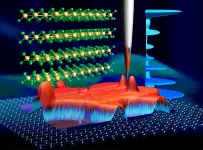INFORMATION:
The project was funded by the U.S. Department of Energy, Office of Basic Energy Sciences, the Division of Materials Sciences and Engineering, and EPSCoR (Established Program to Stimulate Competitive Research). Baral was supported by an Energy Graduate Assistant Fellowship from UW's Office of Academic Affairs.
Researchers resolve controversy over energy gap of Van der Waals material
2021-01-19
(Press-News.org) Previously controversial values of the energy gap of a van der Waals material -- chromium tribromide -- were reported based on various optical measurements. A University of Wyoming faculty member and his research team used scanning tunneling microscopy and spectroscopy measurements that clearly reveal a much smaller energy gap value and resolved the controversy.
"Our results settled a long controversy on one important material property -- the energy gap of the material," says TeYu Chien, an associate professor in the UW Department of Physics and Astronomy. "Our scanning tunneling microscopy and spectroscopy measurements clearly revealed that the energy gap is around 0.3 electron volt (eV), which is much smaller than those measured by optical methods, which ranged from 1.68 to 2.1 eV."
Chien says his team's data further explain those previous optical measurements as being the transitions from various conduction and valence band features rather than detecting the energy gap of the material.
Van der Waals materials are made up of strongly bonded two-dimensional layers that are bound in the third dimension through weaker van der Waals forces. For example, graphite is a van der Waals material that is broadly used in industry in electrodes, lubricants, fibers, heat exchangers and batteries. The nature of the van der Waals forces between layers allows researchers to use Scotch tape to peel the layers into atomic thickness.
Chien is the corresponding author of a paper, titled "Small Energy Gap Revealed in CrBr3 by Scanning Tunneling Spectroscopy," that was published Dec. 8 in Physical Chemistry Chemical Physics, an international journal for the publication of cutting-edge original work in physical chemistry, chemical physics and biophysical chemistry. The paper has been selected into the journal's "hot articles," a theme collection featuring the hottest work published in Physical Chemistry Chemical Physics. This work also will be featured on the outside front cover of the upcoming print edition.
Dinesh Baral, a UW graduate student from Nepal, was the lead author of the paper. He carried out the experimental works on scanning tunneling microscopy and spectroscopy measurement, and data analysis. Other researchers who contributed to the paper are Assistant Professor Jifa Tian, Professor Yuri Dahnovsky and Jinke Tang, a professor and department chair, all from UW's Department of Physics and Astronomy.
Graduate students involved with the research included Zhuangen Fu and Aaron Wang, both from China; Uppalaiah Erugu, of India; Rabindra Dulal and Narendra Shrestha, both of Nepal; and Andrei Zadorozhnyi, of Russia.
Since the first isolated graphene -- atomically thin graphite -- in 2004, various van der Waals materials with properties of metal, semimetal, semiconductor, insulator and superconductor have been confirmed. The magnetic van der Waals materials did not join the graphene family until 2017.
Chromium trihalides are one family of the key van der Waals magnetic materials and have been used to explore the potential for spintronic applications, in which the magnetic moment of the electron is used for computing and information storage rather than using the charge properties of the electrons for conventional electronics.
Because van der Waals materials have very weak interlayer interactions and relatively stronger intralayer atom-to-atom bonding, this allows researchers to peel them and stack them for any combination of materials at atomic thickness.
"This peeling of the van der Waals materials is like peeling the onion skins, but at the atomic level," Baral explains.
Scanning tunneling microscopy and spectroscopy is an imaging tool capable of measuring atomic resolution images, along with the electronic properties in that scale. Chromium tribromide flakes were peeled off from bulk crystal into atomically thin thickness and transferred onto a conducting substrate, such as highly oriented pyrolytic graphite, for the study.
"The understanding of the energy gap of chromium tribromide resolves the existing controversy for the scientific community," Chien says. "This also is the key in better controlling the spintronics devices involving chromium tribromide."
The results of the study will provide researchers a better understanding of this important material for applications in spintronics and quantum materials, Chien says.
"Materials having such properties have potential applications in engineering at minimizing the size of the electronic and spintronic devices toward atomic level," he says.
ELSE PRESS RELEASES FROM THIS DATE:
A most distant signal
2021-01-19
Nearly every galaxy hosts a monster at its center -- a supermassive black hole millions to billions times the size of the Sun. While there's still much to learn about these objects, many scientists believe they are crucial to the formation and structure of galaxies. What's more, some of these black holes are particularly active, whipping up stars, dust and gas into glowing accretion disks emitting powerful radiation into the cosmos as they consume matter around them. These quasars are some of the most distant objects that astronomers can see, and there is now a new record for the farthest one ever observed.
A team of scientists, led by former UC Santa Barbara ...
Money matters to happiness--perhaps more than previously thought
2021-01-19
What's the relationship between money and well-being? "It's one of the most studied questions in my field," says Matthew Killingsworth, a senior fellow at Penn's Wharton School who studies human happiness. "I'm very curious about it. Other scientists are curious about it. Laypeople are curious about it. It's something everyone is navigating all the time."
To answer this question, Killingsworth collected 1.7 million data points from more than 33,000 participants who provided in-the-moment snapshots of their feelings during daily life. In a paper in the Proceedings of the National Academy of Sciences, Killingsworth confirms that money does influence happiness and, contrary to previous influential research on the subject suggesting that this plateaus above ...
New tool removes chemotherapy drugs from water systems
2021-01-19
'What goes in, must come out' is a familiar refrain. It is especially pertinent to the challenges facing UBC researchers who are investigating methods to remove chemicals and pharmaceuticals from public water systems.
Cleaning products, organic dyes and pharmaceuticals are finding their ways into water bodies with wide-ranging negative implications to health and the environment, explains Dr. Mohammad Arjmand, an assistant professor of mechanical engineering at UBC Okanagan.
And while pharmaceuticals like a chemotherapy drug called methotrexate can be highly effective ...
Parkinson's: Initial steps to show nerves their growth direction magnetically
2021-01-19
The team led by Professor Rolf Heumann, Senior Researcher for Molecular Neurobiochemistry at RUB, is hoping that this will allow the effects of neurodegenerative diseases such as Parkinson's to be alleviated over the long term. The results of the work were published on 31 December 2020 in the journal Scientific Reports.
Neurites do not know the way
Restoring brain function following an injury or due to neurodegenerative diseases remains an unresolved problem in neuroscience and medicine. Regeneration in the central nervous system is only possible to a very limited ...
Purely organic hole transporter
2021-01-19
Durable, high-performing perovskite solar cells also require durable, high-performing charge-transporting layers. Scientists have developed the first organic hole transporter that does not need a dopant to attain high charge mobility and stability. According to the study published in the journal Angewandte Chemie, this novel hole-transporting layer outperforms reference materials and protects the perovskite organic cell from air humidity.
In perovskite solar cells, the perovskite light absorption layer is sandwiched between two charge-transporting layers, which collect the generated holes and electrons and transport them to the electrodes. These charge transportation ...
Cancer-related suicide declined in the US during the past two decades
2021-01-19
ATLANTA - JANUARY 19, 2021 - Despite increases in overall suicide rates in the United States during the past two decades, cancer-related suicides declined by 2.8% per year, according to a new study by the American Cancer Society. The study, appearing in JNCI: The Journal of the National Cancer Institute, found that the largest declines in cancer-related suicide rates were among high-risk populations, suggesting an evolving role of psycho-oncology and palliative and hospice care for cancer patients and survivors during this period.
To examine the trends in cancer-related suicides compared to overall suicides in the U.S., investigators led by Xuesong Han, PhD, calculated average annual percentage change of suicide rates stratified by risk factors including ...
Testing the waters: Analyzing different solid states of water on other planets and moons
2021-01-19
Just like on Earth, water on other planets, satellites, and even comets comes in a variety of forms depending on multiple factors such as pressure and temperature. Aside from the gaseous, liquid, and solid states we are accustomed to, water can form a different type of crystalline solid called clathrate hydrate. Although they look similar to ice, clathrate hydrates have actually small water-based cages in which smaller molecules are trapped. These trapped "guest" molecules are essential for preserving the crystalline structure of clathrate hydrates, which would otherwise "collapse" into regular ice or water.
Clathrate hydrates play a crucial role in the evolution of a planet or satellite's ...
Sequencing of wastewater useful for control of SARS-CoV-2
2021-01-19
Washington, DC - January 19, 2021 - Viral genome sequencing of wastewater can detect new SARS-CoV-2 variants before they are detected by local clinical sequencing, according to a new study reported in mBio, an open-access journal of the American Society for Microbiology. The ability to track SARS-CoV-2 mutations in wastewater could be particularly useful for tracking new variants, like the B.1.17 strain that is now widespread in the U.K. and has already been introduced in the U.S.
"SARS CoV-2 virus is excreted by individuals that are infected by COVID -19and the fecal waste ends up in the wastewater systems. By sampling wastewater, we can get information on infections for a whole population. Some wastewater systems serve several thousand people. ...
A clinical trial provides encouraging results on ivermectin for reducing mild COVID-19
2021-01-19
A small pilot study suggests that early administration of ivermectin can reduce viral loads and symptom duration in patients with mild COVID-19, which in turn could help reduce viral transmission. The study, which is part of the SAINT project and has been led by the University of Navarra Clinic and the Barcelona Institute for Global Health (ISGlobal), an institution supported by the "la Caixa" Foundation, warrants further exploration in larger clinical trials. The findings of the pilot study have been published in EClinicalMedicine, a clinical journal published by The Lancet.
We ...
Inflamed environment is C. diff paradise
2021-01-19
A new study from North Carolina State University shows that the inflammation caused by Clostridioides difficile (C. diff) infection gives the pathogen a two-fold advantage: by both creating an inhospitable environment for competing bacteria and providing nutrients that enable C. diff to thrive.
C. diff is a bacterium that causes diarrhea, often with severe or even fatal consequences. As part of its growth cycle, C. diff produces two toxins which cause inflammation and damage the lining of the gut.
"C. diff thrives when other microbes in the gut are absent - which is why it is more prevalent following antibiotic ...



